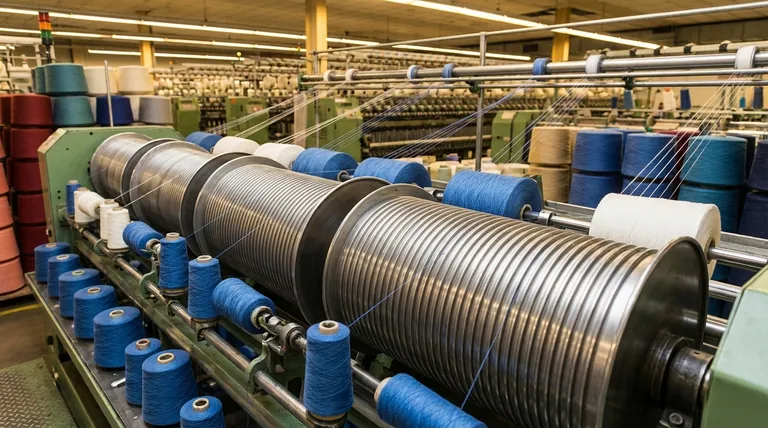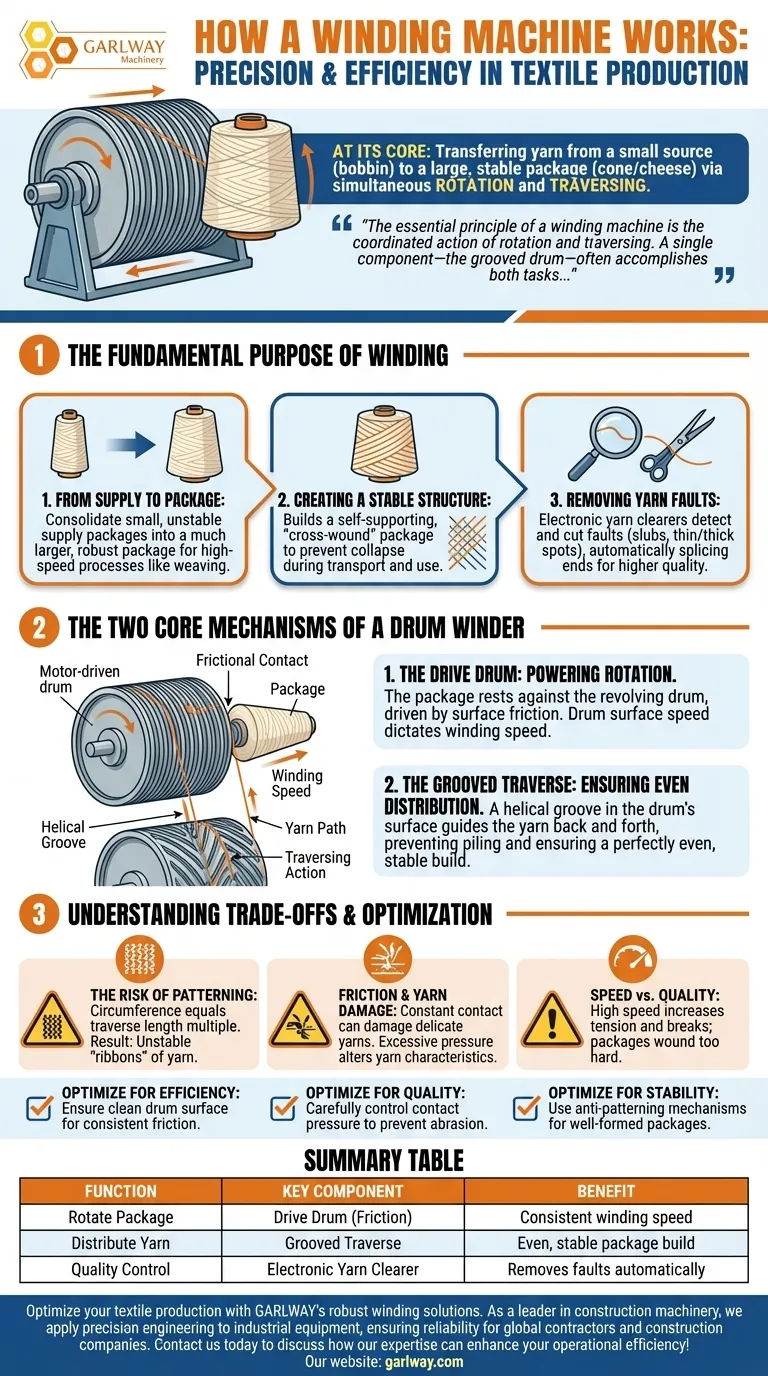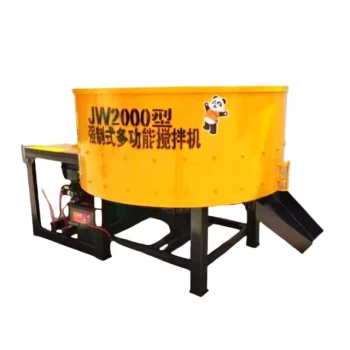At its core, a winding machine works by transferring yarn or thread from one source, like a bobbin, onto a larger, more stable package, such as a cone or cheese. In the most common design, this is achieved through two simultaneous actions: a rotating drum drives the new package through friction, while precisely engineered grooves in that same drum guide the yarn back and forth to ensure it is laid down evenly.
The essential principle of a winding machine is the coordinated action of rotation and traversing. A single component—the grooved drum—often accomplishes both tasks, driving the package via friction while guiding the yarn to build a stable, uniformly dense structure.

The Fundamental Purpose of Winding
Before diving into the mechanics, it's critical to understand why winding is a necessary step in textile production. The small packages from a spinning frame are not suitable for high-speed, large-scale processes like weaving or knitting.
From Supply to Package
The primary job of the winder is to take yarn from these smaller, often unstable supply packages and create a much larger, more robust package. This consolidation significantly improves efficiency in subsequent manufacturing stages by reducing the number of times a machine must be stopped to load new material.
Creating a Stable Structure
A key function is to create a "cross-wound" package. By laying the yarn at an angle as it traverses back and forth, the machine builds a self-supporting structure. This prevents the package from collapsing or sloughing off during transport and use.
Removing Yarn Faults
Modern winding machines are not just mechanical winders; they are quality control checkpoints. They often incorporate electronic yarn clearers that detect and cut out faults like thick spots, thin spots, or slubs, automatically splicing the yarn ends back together to create a higher-quality final thread.
The Two Core Mechanisms of a Drum Winder
The grooved drum winder is a classic and efficient design that elegantly solves the two main challenges of winding: rotating the package and distributing the yarn.
The Drive Drum: Powering Rotation
The new package (the cone or cheese) is not directly powered by a motor. Instead, it rests against a larger, motor-driven cylinder called a drum.
The frictional contact between the surface of the revolving drum and the surface of the package causes the package to rotate. The surface speed of the drum dictates the winding speed of the yarn.
The Grooved Traverse: Ensuring Even Distribution
To prevent all the yarn from piling up in one place, a traversing mechanism is needed to move it back and forth along the length of the package.
On a drum winder, this is achieved by a helical groove cut into the drum's surface. The yarn is fed into this groove, and as the drum rotates, the path of the groove forces the yarn to travel from one end of the package to the other, ensuring a perfectly even and stable build.
Understanding the Trade-offs
While the drum winding system is efficient, it involves inherent mechanical trade-offs that operators must manage to ensure quality.
The Risk of Patterning
A significant risk in winding is creating "pattern zones" or "ribbons." This defect occurs when the circumference of the package becomes a simple multiple of the traverse length, causing the yarn to be laid down in the same place on successive rotations. This creates an unstable, uneven package.
Friction and Yarn Damage
The entire system relies on friction. While effective, this constant contact can be detrimental to delicate, low-twist, or specialty yarns. Excessive pressure between the drum and the package can abrade or flatten the yarn, altering its characteristics.
Speed vs. Quality
As with most manufacturing processes, there is a direct trade-off between speed and quality. Winding at excessively high speeds can increase yarn tension, leading to more breaks and potential stretching. It can also cause the package to be wound too hard, making it difficult to unwind in the next process.
Making the Right Choice for Your Goal
Understanding the core mechanics allows you to optimize the winding process based on your specific priority.
- If your primary focus is production efficiency: Ensure the drum surface is clean and provides consistent frictional contact to maintain a constant winding speed and minimize slippage.
- If your primary focus is yarn quality: Carefully control the contact pressure between the drum and the package to prevent abrasion, especially for delicate or high-value yarns.
- If your primary focus is package stability: Utilize anti-patterning mechanisms and ensure the groove traverse system is appropriate for the yarn count to build a well-formed package that performs flawlessly in downstream processes.
Ultimately, mastering a winding machine means balancing the drive for speed with the mechanical realities of friction and geometry to produce a perfect package.
Summary Table:
| Function | Key Component | Benefit |
|---|---|---|
| Rotate Package | Drive Drum (Friction) | Consistent winding speed |
| Distribute Yarn | Grooved Traverse | Even, stable package build |
| Quality Control | Electronic Yarn Clearer | Removes faults automatically |
Optimize your textile production with GARLWAY's robust winding solutions. As a leader in construction machinery, we apply precision engineering to industrial equipment, ensuring reliability for global contractors and construction companies. Contact us today to discuss how our expertise can enhance your operational efficiency!
Visual Guide

Related Products
- Warn Winch Windlass Boat Trailer Winch
- Electric 120V Boat Winch by Badlands
- Best 18000 Pound Drum Anchor Trailer Winch
- 12000 lb Heavy Duty Electric Boat Winch
- Ready Mixer Machine for Construction Ready Mix Machinery
People Also Ask
- How should a boat trailer winch be properly used? A Step-by-Step Guide for Safe Loading
- How often should a boat trailer winch be replaced? Your Guide to Safety and Longevity
- How are trailer winches rated? A Guide to Safe & Effective Load Capacity
- What is the purpose of boat trailer winches? Safely and Efficiently Load Your Boat
- Is installation of boat trailer winches difficult? A Guide to DIY vs. Pro Installation



















